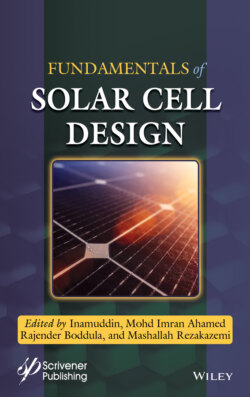Читать книгу Fundamentals of Solar Cell Design - Rajender Boddula - Страница 28
2
Plasmonic Solar Cells
ОглавлениеT. Shiyani1, S. K. Mahapatra2 and I. Banerjee1*
1School of Nanosciences, Central University of Gujarat, Gandhinagar, Gujarat, India
2School of Basic and Applied Sciences, Central University of Punjab, Bathinda, India
Abstract
Photovoltaic (PV) cell is a fundamental solar energy conversion device that converts light energy into electric energy. The light absorption and charge recombination are main limiting factors on the efficiency of PV cell or solar cell. A limited efficiency of PV devices makes them less effective in market for clean energy production. Various tactics and methods are demonstrated to enhance the solar cell performance. Metallic nanoparticles have been utilized to fabricate solar cells because of its novel properties such as large surface to volume ratio and surface plasmon resonance (SPR). Plasmonic nanostructures can influence the absorption of light through scattering of surrounding molecules or particles. The plasmonic nanostructures can scatter or concentrate light at subwavelength scale for increasing absorption in active layer and hence enhancing the efficiency of PV devices. Therefore, the plasmonic nanostructures are promising candidates to develop high efficiency solar cells. We discuss about the fundamental mechanisms, ability to scale up the plasmonic with tailored optical properties, solar cell design, and recent advancements in plasmonic solar cells to generate clean energy and solar fuels.
Keywords: Plasmonic nanostructures, thin film, surface plasmon resonance, light scattering, solar cell
